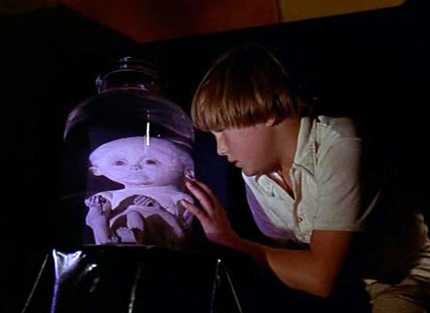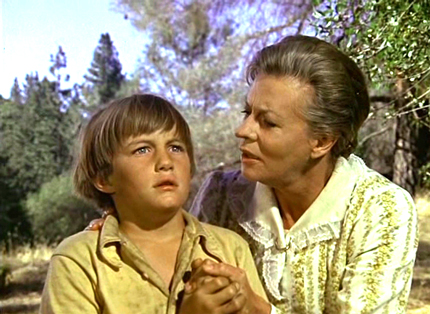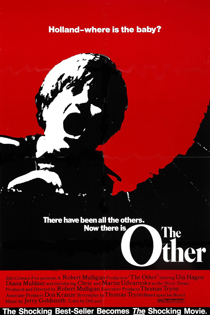|
|
Reviewed by Glenn Erickson
A highly respected 'actors' director', Robert Mulligan will always be remembered for the admired To Kill a Mockingbird. Although almost all of his pictures are ambitious and interesting, Mulligan had as many no-shows (The Pursuit of Happiness) as successes (The Great Impostor, Up the Down Staircase, Summer of '42). On a roll after a big hit, Mulligan also produced 1972's The Other, a horror thriller written by actor-turned author Tom Tryon. It's a murky mystery from the Deep Depression era, focusing on the kind of material Mulligan had excelled at before. Tryon's novel was a cross between Bradbury's Something Wicked This Way Comes and the play/movie The Bad Seed. I was an usher at the National Theater in Westwood when The Other premiered, and I have to say that it was considered quality goods on all levels. The large auditorium filled every weekend for several weeks.

In rural New England, young twins Niles and Holland Perry (Chris and Martin Udvarnoky) are keeping dark secrets to themselves. Their beautiful mother Alexandra (Diana Muldaur) lives in her room, recovering from a nervous breakdown. Niles plays a game with his doting Grandmother Ada (Uta Hagen) in which he shares the experiences of animals, and is convinced that he can fly with a crow. Niles must increasingly cover for the bad behavior of his brother Holland, who pulls malicious tricks on neighbors. But Niles doesn't always tell the truth, either. He carries with him a couple of items that were supposed to have been buried with a relative, and every time the secret leaks out, somebody is killed in a freakish accident. Nobody even begins to believe that little Niles and Holland could be responsible.
The Other has a trick narrative that certainly fooled me the first time through, and it's too good of a gimmick to spoil. By 1971 horror films had become pretty rough; a couple of years later The Exorcist would leverage even nastier scares for a huge box office success. This horror effort is well directed but ultimately fails to deliver much beyond sickening shocks. The boys play in forbidden cellars and rooms in the barn. They sneak into a carnival's freak tent, to marvel at a misshapen fetus. Every time Niles's back is turned, Holland is off doing something very, very bad.

The horror-thriller angle is played for maybe one cruel laugh -- the poor silly neighbor lady -- and a lot of grim unpleasantness. People start dying, some of them children. A horrible secret is revealed in a flashback at a water well, almost like a later J-Horror movie; the fragile Alexandra is found crying at this well, beyond consoling. Although some of this is intriguing, none of it is fun. When Niles and Holland's true nature is found out, the movie's idea of horror is to make certain that the very worst thing that can possibly happen, happens. And that's the payoff. The Other is skillful filmmaking and communicates its mood well, but that mood is utter desolation. I'd call the movie a success, despite the fact that every audience left the theater looking depressed, as if their dog had just died. Instead of word of mouth killing the picture off, it continued to pull in crowds for a couple of weeks.
Without getting into the exact nature of the horror, I'll just say that it is foretold through a fairy story and a topical reference to Charles Lindbergh seen in a newspaper headline.
Jerry Goldsmith's music leaps from a simple, 'mirrored' melody line to sweeping orchestrations when Niles 'takes to the air' in his fantastic flight with the crow. 1 With his ace cameraman Robert Surtees, director Mulligan uses soft focus and long zoom shots to isolate Niles and Holland in a sunny, golden childhood of --- malevolent doings. Mulligan plays some very clever tricks in the way the twins are filmed, which also sneak up on the viewer. 2

Chris and Martin Udvarnoky are good as the twins. Spending most of the movie in worried denial, Chris' harping about unavoidable accidents becomes a little tiresome, but that's intended. Top-billed Uta Hagen was a legendary stage actress. Among many other famed parts, she originated Martha in the Broadway production of Who's Afraid of Virginia Woolf? She'd been in a few TV shows but The Other was her first feature. Beautiful Diana Muldaur's sickly mother is a sketch, as are the rest of the film's supporting roles. Muldaur evokes a lot of pity just by being beautiful -- in fact, if the movie's style weren't so realistic, we'd wonder if the mother's appearance was idealized to reflect Niles' adoration. No, she's apparently gone all Tennessee Williams on us, and languishes in sorrow wearing full makeup, perfect hair and a gorgeous nightgown.

It's difficult to really discuss The Other without spoiling it. It's a respectable entry in the 'horror of personality' subgenre, where one person seems to psychologically possess another. It leans a bit too heavily on the "children are too innocent to be suspected" theme; especially when Grandmother Ada knows what she knows about Niles, yet chooses to keep his secret to herself. Ms. Hagen raises the emotional level to tragic status, when most of us will be thinking, "was this atrocity necessary?"
The Twilight Time Blu-ray of The Other is a flawless rendering of this sunny, summer-y horror item. The images look less mushy than tehy did on the big screen. One can confirm the use of heavy diffusion by watching carefully -- in some shots we can see what looks like faint net patterning for a brief moment. The original trailer is quite good, and the isolated score option allows us to see how carefully Jerry Goldsmith tracks the emotional curves in the story. His choice of where and where not to place music underscoring is also interesting.

Twilight Time's Julie Kirgo gives background on the show and its personnel, including Tom Tryon's change of vocation from actor to writer. She also thoughtfully avoids spoiling the movie's surprises. The Other isn't like Rosebud in Citizen Kane; most viewers have yet to discover it.
On a scale of Excellent, Good, Fair, and Poor,
The Other Blu-ray rates:
Movie: Very Good
Video: Excellent
Sound: Excellent
Supplements: Isolated Score Track, Trailer
Deaf and Hearing-impaired Friendly?
YES; Subtitles: English
Packaging: Keep case
Reviewed: October 21, 2013
Footnotes:
1. Fellow National usher and student of music Mark Stern told me that Jerry Goldsmith's "simple" little melody, the one first heard under the main titles, is actually quite clever in a way fitting to the theme of The Other. He said that the first melody line proceeds through several notes, and then reverses direction and retraces the same set of notes back to the beginning, like a musical Palindrome. To Mark, this melody mirrored the situation of the Good and Evil twin. Do other music-minded Savant readers see the same pattern?
Return
2. Let's see, how to say this so that only readers already familiar with the film will understand... A few observations: moviemakers were known to hire twin children to play a single role, as a way of getting a full days' work in while obeying child labor laws ... one twin could work a couple of hours, and then be replaced by the other twin. And there's something that often isn't noticed until one sees the film a second time: Niles and Martin appear together in the same shot just once or twice, but never together in the same frame. To many viewers, it looks as if one child played both parts, and that one of the "Udvarnokys" in the cast list is a cheat, like "Lupo Prezzo" in The 1,000 Eyes of Dr. Mabuse.
For my project two film at UCLA I came up with two separate ideas that show off special effects by fellow students Clark Dugger and Hoyt Yeatman. One idea was inspired by a dream. The second was to be a trick picture about twins. First I'd duplicate my actor in the same frame with obvious split screen mattes. Then I'd use a double for a couple of shots, and not necessarily a very good double. Then we'd do one of those (mostly) silent movie tricks where "twins" shake hands, but one arm is a trick arm, etc. But then, a sequence would begin in which one twin moved behind the other, then in front of him, we'd pull focus, etc. -- the audience would look for the trick effect and wonder, how did we possibly do it? The answer of course is that I would use real twins for the later shots. Nowadays my film idea wouldn't work because CG effects have wiped out the relevance of "clever trick film solutions" for problems like this.
I didn't film the twins story because the brother of the twin that inspired the idea wasn't available. Too bad.
Return

DVD Savant Text © Copyright 2013 Glenn Erickson
See more exclusive reviews on the Savant Main Page.
Reviews on the Savant main site have additional credits information and are often updated and annotated with reader input and graphics.
Also, don't forget the
2011 Savant Wish List.
T'was Ever Thus.
Return to Top of Page
|

